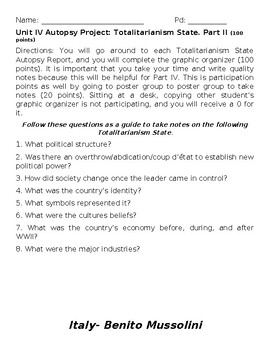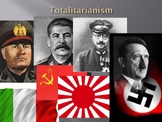Autopsy: Totalitarianism State, Part II and III
Social Studies by Mr G
3 Followers
Grade Levels
PreK - 12th, Higher Education, Adult Education, Homeschool, Staff
Resource Type
Standards
CCSSSL.9-10.1
CCSSSL.9-10.1a
CCSSSL.9-10.1b
CCSSSL.9-10.1c
CCSSSL.9-10.1d
Formats Included
- Word Document File
Pages
8 pages
Social Studies by Mr G
3 Followers
Also included in
- In the broadest sense, totalitarianism is characterized by strong central rule that attempts to control and direct all aspects of individual life through coercion and repression. The students will be depicting this through an autopsy project where the students will be drawing a person him/herself orPrice $14.36Original Price $15.96Save $1.60
Description
Part II. The Gallery Walk
The students will go around to each New World Empires Autopsy Report, and complete the graphic organizer. It is important that take your time and write quality notes because this will be helpful for Part IV.
Part III. Rater
Embedded is a student partner rater as well a reflection on the project itself.
Total Pages
8 pages
Answer Key
N/A
Teaching Duration
2 days
Report this resource to TPT
Reported resources will be reviewed by our team. Report this resource to let us know if this resource violates TPT’s content guidelines.
Standards
to see state-specific standards (only available in the US).
CCSSSL.9-10.1
Initiate and participate effectively in a range of collaborative discussions (one-on-one, in groups, and teacher-led) with diverse partners on grades 9–10 topics, texts, and issues, building on others’ ideas and expressing their own clearly and persuasively.
CCSSSL.9-10.1a
Come to discussions prepared, having read and researched material under study; explicitly draw on that preparation by referring to evidence from texts and other research on the topic or issue to stimulate a thoughtful, well-reasoned exchange of ideas.
CCSSSL.9-10.1b
Work with peers to set rules for collegial discussions and decision-making (e.g., informal consensus, taking votes on key issues, presentation of alternate views), clear goals and deadlines, and individual roles as needed.
CCSSSL.9-10.1c
Propel conversations by posing and responding to questions that relate the current discussion to broader themes or larger ideas; actively incorporate others into the discussion; and clarify, verify, or challenge ideas and conclusions.
CCSSSL.9-10.1d
Respond thoughtfully to diverse perspectives, summarize points of agreement and disagreement, and, when warranted, qualify or justify their own views and understanding and make new connections in light of the evidence and reasoning presented.






